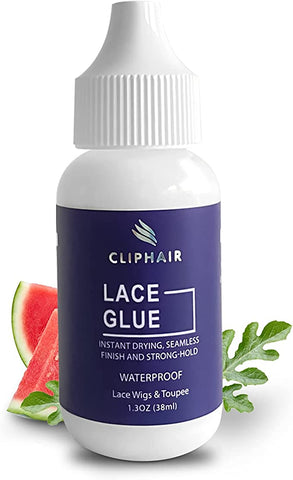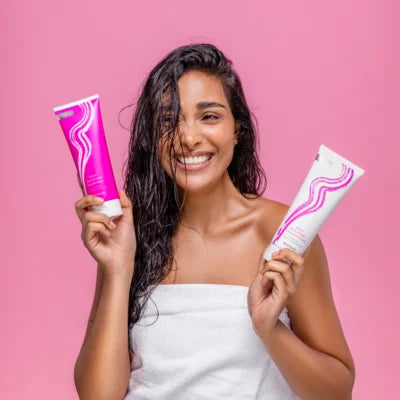Glue-in hair extensions may not be the most popular method of extension but they are still widely used in the hair industry mainly due to their low maintenance, longevity, and lower cost. The downside is they are harder to remove than glue-less options and can occasionally leave an unwanted sticky residue in the natural hair which can be tricky to remove if you don’t know the right tricks! In todays blog, we are going to share our top tips for removing glue -in hair extensions by sharing what products to use for each type and how to safely get rid of leftover residue at home.
Glue In Hair Extensions
Glued-in hair extensions have been around for a long time: in fact, they are one of the earliest methods of individual extensions which is why there any many variants in today's market. Traditionally they are applied to the hair using a heat connecter which melts the tip of the extension onto a strand of natural hair bonding the two together. Tape hair extensions do not need the use of heat during the application however they are attached using an adhesive tab so they can still technically be classed as glue-in extensions. Hair extension glue is also widely used to apply weave hair extensions or wigs however this practice is not as common due to newer more gentle methods that have been invented such as the LA Weave. To find out more check out our blog “Everything you need to know about the LA weave” .
What Are Keratin Bond Extensions?
Keratin bond hair extensions are the most common form of glued-in hair extension, suitable for almost all hair types apart from extremely fine hair they are discreet, low maintenance, and cheaper than most micro ring systems. They are applied with a heat connecter that fuses the extension tip to the natural hair, they can stay in for up to 4 months without removal or maintenance. It is possible to re-use the extensions after they have been removed but re-tipping them is a delicate and time-consuming process so most people opt for a new set each time. The most frequent types of Keratin bond extensions are U-Tip hair extensions and Flat tip hair extensions.
U-Tip Hair Extensions
U-Tips or as they are also known, Nail tip hair extensions are curved at the top just like a fingernail (hence the name). This allows for easier rolling when the tip is melting around the hair and also helps with neater placement.
Flat Tip Hair Extensions
Flat tips are a newer version of the keratin bond method, still glued in by using a heat connector tool but instead of rolling the tip onto the hair the flat tip is simply welded on in the same shape, this lays completely flat to the head.
How To Remove Keratin Bond Extensions?
To remove any type of glued-in extension you will need either an oil-based or alcohol-based glue remover product. Although oil-based removers are better for the hair and skin to remove keratin bonds we would advise opting for an alcohol-based remover as they are stronger and more effective for this extension type. BEYofi by Bernard Evans is the bond remover we recommend, see below for a step-by-step on removing the extensions with this product.
Step 1
Using your hair extension pliers or clamp tool, squeeze the bonds on the row you are working on to loosen them slightly.
Step 2
Apply a generous amount of your bond remover to the tips and let it sit for 1-2 minutes.
Step 3
The remover will have begun to disintegrate and loosen the glue from the hair. Using your pliers, gently scrunch the tips to encourage them to fall away from the natural hair.
Step 4
Once the bond is removed, use a fine-toothed comb and some more of your remover solution to remove any leftover residue.
Step 5
This step is super important after any alcohol-based remover session so do not skip it! After the extensions are removed shampoo the hair twice with a cleansing shampoo then finish with a strong, deep conditioning treatment that should be left on the hair for a minimum of 30 minutes to restore moisture and hydration.
How To Get Extensions Glue Out Of Hair?
Leftover glue or adhesive in your natural hair can be really uncomfortable and annoying so it's important to make sure it is all completely out. If after your removal you still feel sticky residue or glue in your hair you should contact your stylist and ask for a second removal appointment. If this is not an option there are a few tips for removing it yourself at home. If you do not have a professional bond remover you can use hair oils and strong conditioner as an alternative, this will only work for leftover residue not remove bonded extensions.
Step 1
Start by giving your hair a wash with a clarifying shampoo, this may help to remove some of the glue and the cleansing ingredients work to remove impurities.
Step 2
Add some Argan oil to your conditioner and apply it all over, including the roots.
Step 3
Using a drop of argan or coconut oil, pinpoint the areas of residue and apply another layer. Allow the conditioner and oil to sit on the hair for 5-10 minutes to help loosen the glue.
Step 4
Working up from the name in horizontal rows, use a fine-toothed comb to gently comb the residue out of the hair. Clean your comb before each new section to prevent putting the glue back into the hair.
How To Remove Tape In Hair Extensions?
Although Tape-Ins are not technically glued in or fused to the hair they do still use an adhesive strip which is a gentle form of glue so a remover will need to be used to remove them. For Tapes, as they are less securely attached to the hair an oil-based remover is perfectly strong enough to remove them, this is far better for the hair and skin than harsh alcohol-based ones. Our Cliphair Tape Remover is the number one top-rated tape remover on Amazon and one of our biggest sellers due to its gentle ingredients, fruity scent, and quality results. See below for a step-by-step on how to use it.
Step 1
Working row by row, saturate each tape with a generous amount of oil remover.
Step 2
Allow the remover to sit on the tabs for 3-5 minutes to begin dissolving the adhesive.
Step 3
Using the end of a pin tail comb gently prise open the tape sandwich, spraying with more remover as you go to encourage the tapes to open.
Step 4
Once the tapes have slid away from the hair, use your pintail comb to remove any leftover residue.
Find out more about Tape Hair Extensions in our dedicated blog!
Does Vaseline Remove Hair Glue?
No. It may help to lubricate the hair slightly in the same way an oil would but it will not remove glue in hair extension effectively and it could cause tension on the hair if attempted.
What Will Dissolve Hair Extensions Glue?
The best products to use to dissolve hair extension glue are alcohol bond removers and oil-based removers. Oils not designed specifically for extension removal may help to remove leftover residue however it's always best to use a professional remover to take out the actual extensions to avoid any damage to the natural hair. Find out more in our blog "How to remove hair extensions at home"
How To Remove Wig Glue?

If there is severe thinning around the crown and parting area, extensions arnt always suitable as they will be extremely difficult to hide. In this scenario people usually opt for wigs or hair toppers which can provide full coverage, for extra security wig glue is often used to attach the piece to the hair. Our Cliphair Lace Wig Glue is one of the best sellers in this category on Amazon, thanks to its gentle ingridients and fast drying functionality its becoming a firm favourite amongst wig users worldwide. To remove wig glue a skin-safe adhesive solvent is used.













